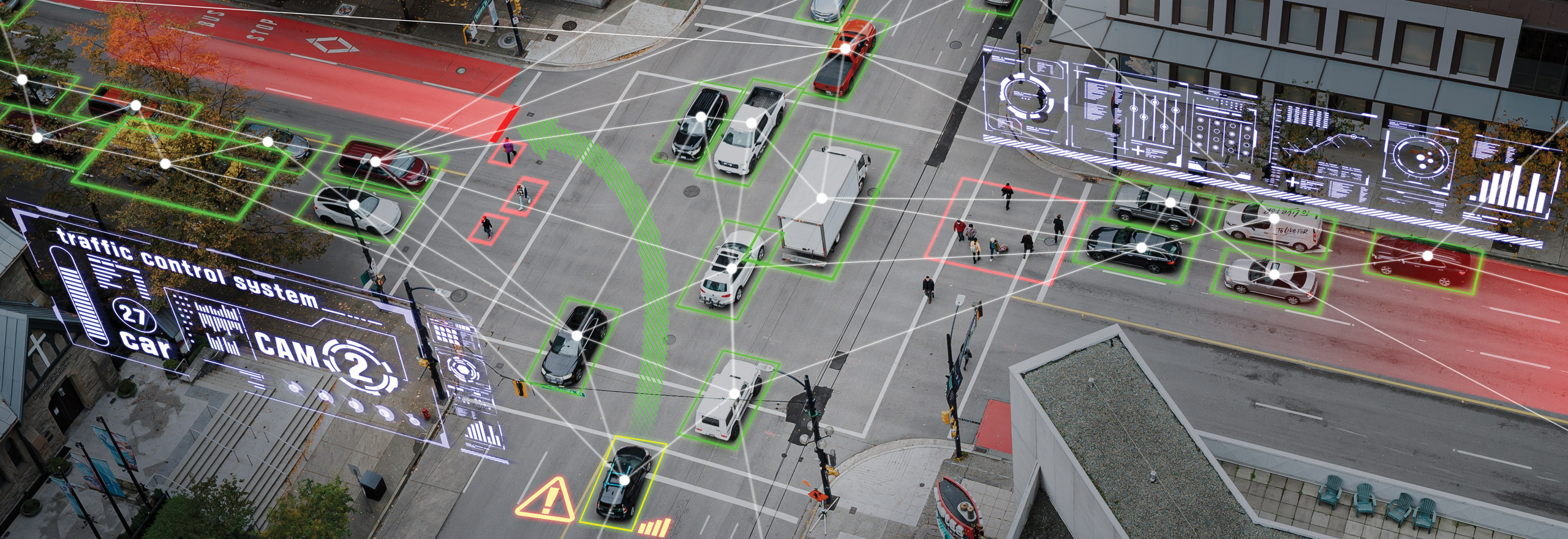VTD unterstützt Waylancer mit schnellen, gleichlaufenden Simulationen
Furea Shirai, Product Marketing Manager, Hexagon, Manufacturing Intelligence Division

Engineering Reality 2024 Ausgabe 1
Accelerate Smart Manufacturing
Shanghai Waylancer Automobile Technology Co. Ltd wurde 2017 vom SAIC Group Innovation Fund gegründet. Waylancer bietet Entwicklungs-, Software- und Big-Data-Produktdienstleistungen für intelligente Fahrsimulationstests. Das Unternehmen hat eine Testplattform für Simulationen in der Cloud für Unternehmen wie Lotus Cars, Changan Auto und GAC Grou bereitgestellt.
Anforderung: Kundensupport bei der Einführung von ADAS/AD
Waylancer wollte seine OEM-Kunden dabei unterstützen, den Branchentrend hin zu modernen Fahrerassistenzsystemen/automatisiertem Fahren (ADAS/AD) gewinnbringend für sich zu nutzen. Dabei galt es, einige Herausforderungen zu meistern.
Höhere Komplexität ohne längere Testzeiten
Im Laufe der Jahre sind ADAS und autonome Systeme immer komplexer geworden. In der Vergangenheit waren Systeme zur adaptiven Abstands- und Geschwindigkeitsregelung oder zur Überwachung des toten Winkels mit nur wenige Sensoren ausgestattet. In Zuge der technischen Weiterentwicklung nimmt auch die Anzahl der Sensoren in Fahrzeugen zu – in einigen Fällen sind es bis zu 20 Sensoren, wobei deren Informationen mit denen anderer „verschmolzen“ werden müssen, um entscheidungsweisend agieren zu können. OEMs müssen mehrere Daten von verschiedenen Sensoren bündeln.Was die Durchführung von Testszenarien betrifft, haben Sie aber nicht mehr Zeit wie zuvor.
„Ein gutes Beispiel ist eine Kamera, die zwar verschiedenartige Objekte gut erkennt, aber beim Versuch, deren Abstand zum Fahrzeug zu erkennen, schlecht abschneidet. Gleichzeitig kann ein Radarsensor ein Objekt nicht erkennen, aber ganz hervorragend die Entfernung dieses Objekts zum Fahrzeug bestimmen“, erklärt Dr. Furea Shirai, Product Marketing Manager bei Hexagon, Autonomous and Cloud.
„Durch die Kombination der Daten beider Sensoren wird die Wahrnehmungsleistung des Fahrzeugs deutlich verbessert. Aber der Hersteller muss immer noch beide Sensoren gemeinsam testen – und sobald die von den Sensoren gelieferten Informationen gebündelt und Testszenarien definiert werden, wird deutlich, wie exponentiell die Anzahl der Szenarien, die Kunden testen und validieren müssen, mittlerweile gestiegen ist. Die Hersteller müssen bei unveränderter Test- und Entwicklungszeit das Zehnfache an Szenarien testen“, sagte sie.
Abhängigkeit von physischen Tests
Oftmals führen OEMs ihrer Testszenarien real durch und testen Prototypen mit vielen möglichen Fahrszenarien auf dem Prüfgelände, um die Fahrzeugleistung zu testen. Dies ist jedoch ein teurer, zeitaufwändiger Prozess, der voraussetzt, dass der Prototyp dem OEM für Tests zur Verfügung steht. Potenzielle Probleme, die dabei festgestellt werden, können demnach erst sehr spät im Design- und Entwicklungsprozess berücksichtigt werden. D. h. Änderungen, die vorgenommen werden müssen, sind bei Bekanntwerden zu diesem Zeitpunkt bereits kostspieliger als zu Beginn des Prozesses.
Hohe Quantität der Tests
Obwohl die Anzahl der Testanwendungen stark gestiegen ist, ist es für Hersteller aus Kosten- und Zeitgründen praktisch unmöglich, alles im Fahrversuch zu testen. Hersteller müssen bestimmte Normen erfüllen – wie in den USA das New Car Assessment Program (NCAP) der National Highway Traffic Safety Administration und die ISO26262, die den internationalen Standard für funktionale Sicherheit bei der Entwicklung elektrischer und elektronischer Systeme für Kraftfahrzeuge definiert. Sie müssen aber weit über diese Normen hinaus testen, um die vielen Einsatzmöglichkeiten im Straßenverkehr abzudecken.
„Da es keinen Standard für die Bewertung gibt, können wir keinen wirklich hervorragenden Bewertungsalgorithmus entwickeln, der alle ADAS/AD-Algorithmen von Kunden auswerten kann“, sagte Shirai.
Lösungsansatz: Virtual Test Drive (VTD) für schnelle, gleichlaufende Simulationstests
Waylancer begann mit der Evaluierung von straßenbasierten Toolkits und entschied sich schießlich 2018 aufgrund der cloudbasierten Architektur, der Flexibilität bei der Erstellung von Verkehrsszenarien sowie deren exzellenter Rendering-Möglichkeiten für Hexagons Virtual Test Drive (VTD). Darüber hinaus ist VTD eine der führenden Simulationslösungen in China und damit bei chinesischen Automobilherstellern bekannt und etabliert, was ein wichtiges Auswahlkriterium war.
Waylancer bietet seinen Kunden eine schlüsselfertige Testplattform zur Durchführung vieler gleichzeitiger Simulationen in der Cloud. Mithilfe der Docker-Version von VTD in Kombination mit der Cloud-Simulationstestplattform von Waylancer ließen sich Simulationen mit hoher Gleichzeitigkeit in der Cloud realisieren. Der Testprozess konnt erheblich beschleunigt werden. Die Testplattform für Simulationen in der Cloud unterstützt viele Simulationen gleichzeitig, sodass sich mehrere Szenarien zeitgleich testen lassen, was die Iteration von Algorithmen beschleunigt und Kosten spart.
Kundenstimmen
Einer der Kunden von Waylancer, Lotus Cars, nutzt die Cloud-Simulationstestplattform von Waylancer mit 100 VTD-Dockern. Damit kann Lotus gleichzeitig 100 Szenarien simulieren und Auswertungsberichte ausgeben, die aufschlussreiche Informationen zur Verbesserung seines AD-Algorithmus liefern.
Im Laufe von 2.127 Simulationsstunden simulierte VTD 12 Millionen Szenarien, wobei jedes Szenario etwa eine Minute dauerte. Lotus hat einige Szenarien aus dem NCAP abgerufen, aber auch der eigenen vorhandenen Bibliothek.
Außerdem stellte Waylancer eine Simulationstestplattform in der Cloud für einen anderen chinesischen Automobilhersteller mit 50 VTD-Dockern bereit. Die Plattform kombinierte das Open-Source-Verkehrssimulationspaket Simulation of Urban Mobility (SUMO) zur Durchführung einer intelligenten Verkehrssimulation, um realistischere Daten zum Verkehrsfluss für AD-Algorithmen zu erhalten. Sie unterstützte auch eine Kombination mit Ansys AVxcelerate-Sensoren zur Wahrnehmungssimulation, lieferte die Rohdaten von Kameras, Lidars und Millimeterwellenradaren und stellte ein Schulungsset für Wahrnehmungsalgorithmen bereit.
Ergebnisse: 80 Mal schneller als HIL
Zukunftsprognose
Für die Zukunft plant Waylancer die Entwicklung von zwei Plattformen mit VTD:
Zunächst wird die Entwicklung einer cloudbasierten Plattform für Wahrnehmungssimulation zur Online-Konfiguration von Sensoren (wie Kameras, Lidars und Millimeterwellenradare) fokussiert. Auch Lidar- und Millimeterwellenradarsimulationen sollen mithilfe des Optix-Plug-Ins von VTD sowie der Ausgabe von Punktwolken-Daten von VTD unterstützt werden. Die Kamerasimulation wird durch das IG-Modul von VTD unterstützt. Diese liefert Super-Weitwinkel-, semantische Segmentierungs- und andere Kamerabilder.
Außerdem ist eine cloudbasierte Plattform zur Verkehrssimulation geplant, die mit der multimodalen Software zur Verkehrssimulation PTV VISSIM zur Co-Simulation des Verkehrsflusses kombiniert wird. Mithilfe dieser Plattform lassen sich Parameter wie Verkehrsfluss und Verkehrsdichte online konfigurieren. Diese Verkehrsimulationsplattform wird eine Vielzahl integrierter Verkehrsmodelle enthalten, wie z. B. Berücksichtigung des Fahrstreifenwechsels usw.